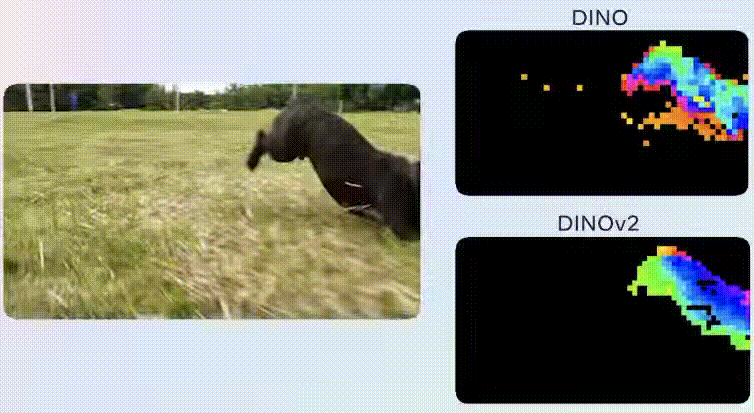TL;DR:
- Meta AI introduces DINOv2 models, a self-supervised learning approach for computer vision.
- DINOv2 achieves impressive results without the need for fine-tuning.
- It overcomes the limitations of human-labeled captions by capturing crucial contextual information.
- Self-supervised learning allows for training on diverse image collections without explicit labels.
- Transitioning from DINO to DINOv2 involved challenges in dataset curation, algorithmic improvements, and distillation.
- DINOv2 utilizes a large, curated, and diverse image dataset for enhanced performance.
- Additional regularization methods ensure stability during training.
- Integration of PyTorch 2’s latest implementations accelerates training speed and reduces memory usage.
- Model distillation compresses knowledge from larger models into smaller ones for faster inference.
- DINOv2 revolutionizes computer vision, empowering researchers and advancing the field.
Main AI News:
In a groundbreaking development, Meta AI has recently unveiled DINOv2 models, ushering in a new era of self-supervised learning for computer vision. These cutting-edge models represent a significant leap forward, achieving results on par with, and even surpassing, traditional approaches and models in the field.
What sets DINOv2 apart is its ability to deliver exceptional performance without the need for fine-tuning, making it an ideal choice for a wide range of computer vision tasks and applications. Unlike previous self-supervised learning methods, DINOv2 can learn from diverse collections of images and features, including depth estimation, without requiring explicit training labels. This remarkable capability is made possible by the innovative self-supervised training method employed by DINOv2.
- The Power of Self-Supervised Learning
1.1. Eliminating the Need for Fine-Tuning
Self-supervised learning represents a powerful paradigm shift in training machine learning models. It eliminates the reliance on vast amounts of labeled data, and DINOv2 models are no exception. These models can be trained on image corpora without the need for metadata, specific hashtags, or image captions. Unlike several recent self-supervised approaches, DINOv2 does not require time-consuming fine-tuning, yielding high-performance features for diverse computer vision applications.
1.2. Surpassing Human Annotation Limitations
While image-text pre-training has gained prominence in recent years, it suffers from limitations tied to human-labeled captions, hindering the comprehensive understanding of images. Such captions often overlook crucial contextual information, such as background details, object position, or size. For instance, a caption labeling a picture of a red table in a yellow room as “A red wooden table” fails to capture important information about the table’s local context. Consequently, this approach underperforms in tasks requiring precise localization information.
Moreover, the reliance on human annotation introduces data collection limitations, restricting the volume of training data available. This becomes particularly challenging in specialized domains where annotating data, such as cellular imagery or animal density estimation, demands a level of expertise that is not readily available at the required scale. By leveraging a self-supervised training approach on cellular imagery, researchers can pave the way for more foundational models, ultimately bolstering advancements in biological research and similar fields.
Transitioning from DINO to DINOv2 necessitated overcoming various challenges, including:
• Curating an extensive and diverse training dataset
• Enhancing the training algorithm and implementation
• Designing an efficient distillation pipeline
2. Evolving from DINO to DINOv2
2.1. Building a Comprehensive and Diverse Image Dataset
A crucial step in developing DINOv2 involved training larger architectures and models to boost performance. However, larger models require sizable datasets for effective training. Since no preexisting datasets fulfilled their requirements, researchers turned to publicly crawled web data and devised a pipeline to select only valuable data, akin to the LASER framework.
To make the collected dataset viable, two essential tasks were undertaken:
• Balancing the data across different concepts and tasks
• Removing irrelevant images
While these tasks could be performed manually, researchers curated a set of seed images from approximately 25 third-party datasets. Subsequently, they expanded this dataset by retrieving closely related images, resulting in a comprehensive corpus comprising 142 million images out of an initial pool of 1.2 billion.
2.2. Algorithmic and Technical Enhancements
Leveraging larger models and datasets brings forth significant challenges, including potential instability and training complexity. To ensure a stable training process, DINOv2 incorporates additional regularization methods inspired by similarity search and classification literature. By drawing from these established techniques, DINOv2 achieves enhanced stability while preserving scalability.
The training process of DINOv2 is further bolstered by the integration of cutting-edge PyTorch 2’s latest mixed-precision and distributed training implementations. This integration facilitates faster implementation and harnesses the same hardware, resulting in twice the training speed and a remarkable reduction in memory usage. As a result, DINOv2 excels in handling larger volumes of data and scaling up model sizes.
2.3. Streamlining Inference Time through Model Distillation
Deploying large models for inference often necessitates powerful hardware, which can pose practical constraints in various use cases. To overcome this hurdle, researchers employ model distillation to compress the knowledge of larger models into more compact counterparts. By leveraging this approach, they successfully condense high-performance architectures, such as ViT-Small, ViT-Base, and ViT-Large, into smaller models with negligible performance costs.
Through the remarkable advancements introduced in DINOv2, Meta AI establishes itself as a frontrunner in self-supervised computer vision models, empowering researchers and practitioners to unlock the full potential of this transformative field.

Conlcusion:
The introduction of DINOv2 models and their self-supervised learning approach represents a significant milestone in the field of computer vision. This innovation has the potential to disrupt the market by offering high-performance computer vision solutions without the need for fine-tuning and human-labeled data. With the ability to learn from diverse image collections and capture contextual information, DINOv2 opens up new possibilities for various industries and applications.
This advancement in technology not only improves performance but also addresses limitations in data collection and annotation. As a result, businesses operating in the computer vision market can leverage DINOv2 models to enhance their products and services, drive innovation, and gain a competitive edge in a rapidly evolving landscape.

